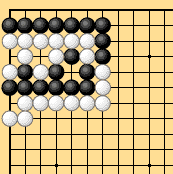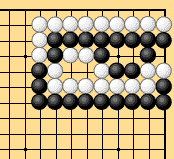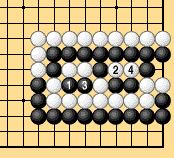 |
2.3.6 Triple Ko, Round-Robin Ko, and Eternal Life (1)
|
Historically, there was the famous Honnoji triple-ko incident in a game
between Nikkai and Kashio Rigen.* More recently, triple
and quadruple ko have occurred in the Nihon Kiin's Oteai. (Dias. 2-14-1
and 2-14-2 show examples of triple and quadruple ko.) If the ordinary ko
rule is followed, a triple ko can cycle endlessly with neither player
able to win. Dias. 2-15-1 to 2-15-3 show another endless position,
called round-robin ko.
|
 |
 |
| Dia. 2-14-1 |
Dia. 2-14-2 |
 |
 |
| Dia. 2-15-1 |
Dia. 2-15-2 |
 |
|
| Dia. 2-15-3 |
|
- *
- Nikkai, later to become Honinbo Sansa, was enlisted as a go
instructor by Oda Nobunaga, the Daimyo whose conquests led in time
to the establishment of the Tokugawa shogunate. On June 1, 1582
Nobunaga watched Nikkai play Kashio Rigen at Honnoji, a monastery
in Kyoto. Unfortunately a triple ko occurred and the game had to be
abandoned. Shortly after the two go players left the monastery, it
was treacherously surrounded and attacked by Akechi Mitsuhide, one of
Nobunaga's own generals, and Nobunaga was killed. The triple ko was
regarded in retrospect as an omen.
|
| |
 |






